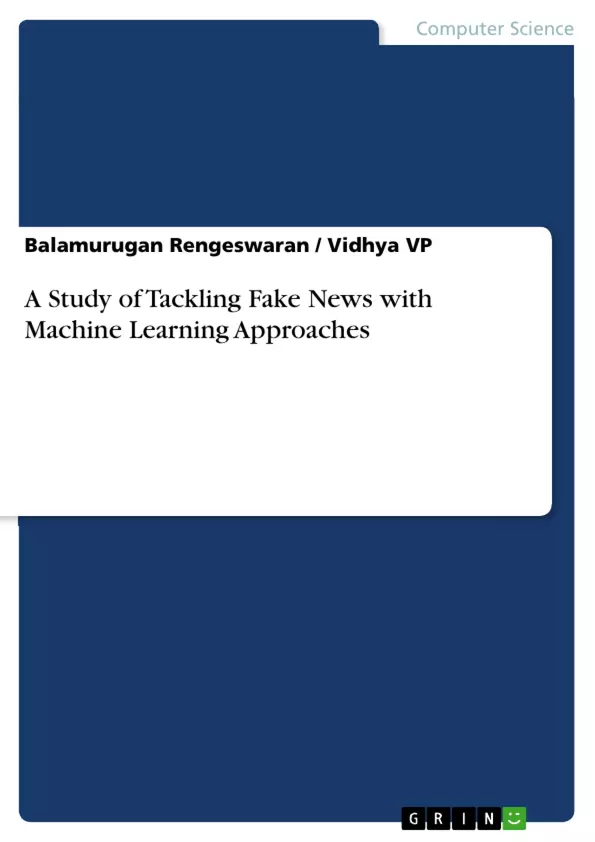The fake news on social media and various other media is wide spreading and is a mat- ter of serious concern due to its ability to cause a lot of social and national damage with destructive impacts. A lot of research is already focused on detecting it. Here we take three data sets namely ” fake news and real news”, ”ISOT” and ”LIAR”. We try to implement six machine learning models on these data sets and trying to find their accu- racy and precision. The models we uses are Decision Tree, Random Forest, Support vector machine, Naive Bayes, KNN and LSTM. WE use tools like python scikit learn and NLP. Python scikit library can be used for feature extraction and textual analysis. We tries to find out which model works best on which data keeping the complexity of the data in mind. We would like to find a perfect model for any of the regional language. But the constrain is the availability of good dataset . So we try to propose a new dataset.
Inhaltsverzeichnis (Table of Contents)
- Introduction
- Literature survey
- Novel Stacking Approach for Accurate Detection of Fake News
- A New Benchmark Dataset for Fake News Detection
- Fake News Detection on Social Media: A Data Mining Perspective
- A benchmark study of machine learning models for online fake news detection.
- Fake News Detection on Social Media using Geometric Deep Learning [1]
- CSI: A Hybrid Deep Model for Fake News Detection [2] .
- TI-CNN: Convolution Neural Networks for Fake News Detection [3]
- Fake news detection using deep learning. [4]
- A Survey on Natural Language Processing for Fake News Detection
- Malayalm Fake NewsDetection Using Machine Learning
- Literature survey
- Proposed Architecture
- Methodology
- Decision Tree.
- Random forest..
- Support Vector Machine
- Naive Bayes
- KNN.
- LSTM
- XGBoost..
- Implementation
- ISOT...
- LIAR
- MALNEWS.
- Results
- Screenshots.
- Code:
Zielsetzung und Themenschwerpunkte (Objectives and Key Themes)
This study aims to tackle the issue of fake news on social media and other platforms by exploring the effectiveness of various machine learning approaches for its detection. The research analyzes three datasets: "fake news and real news", "ISOT", and "LIAR", using six machine learning models - Decision Tree, Random Forest, Support Vector Machine, Naive Bayes, KNN, and LSTM. The study aims to assess the accuracy and precision of these models and determine the best model for each dataset, considering the complexities involved.
- Fake news detection using machine learning
- Evaluation of different machine learning models
- Analysis of various datasets for fake news detection
- Development of a new dataset for regional languages
- Application of natural language processing (NLP) techniques
Zusammenfassung der Kapitel (Chapter Summaries)
- Introduction: This chapter introduces the growing problem of fake news, highlighting its detrimental social and national impact. It then provides a literature survey of previous research on fake news detection, discussing various approaches and challenges.
- Proposed Architecture: This chapter presents the proposed architecture for tackling fake news detection. It outlines the key components and functionalities of the system, including data collection, preprocessing, feature extraction, model training, and evaluation.
- Methodology: This chapter delves into the different machine learning models employed in the study, providing detailed explanations of their algorithms and implementation procedures. The chapter covers Decision Tree, Random Forest, Support Vector Machine, Naive Bayes, KNN, LSTM, and XGBoost.
- Implementation: This chapter describes the implementation of the chosen machine learning models on three datasets: "fake news and real news", "ISOT", and "LIAR". It discusses the data preparation, feature engineering, and model training processes for each dataset.
- Results: This chapter presents the results of the model evaluation, showcasing the accuracy, precision, and other performance metrics of the different models across the three datasets. It analyzes the strengths and weaknesses of each model and provides insights into their suitability for different types of fake news.
Schlüsselwörter (Keywords)
This study focuses on key themes and concepts related to fake news detection, encompassing machine learning approaches, data analysis, and natural language processing. This research explores the effectiveness of different machine learning models like Decision Tree, Random Forest, Support Vector Machine, Naive Bayes, KNN, and LSTM. It also involves the analysis of various datasets such as "fake news and real news", "ISOT", and "LIAR", and aims to create a new dataset for regional languages. This research uses tools like Python Scikit Learn and NLP for feature extraction and textual analysis, aiming to contribute to the advancement of techniques for tackling the growing problem of fake news.
- Quote paper
- Balamurugan Rengeswaran (Author), Vidhya VP (Author), 2024, A Study of Tackling Fake News with Machine Learning Approaches, Munich, GRIN Verlag, https://www.grin.com/document/1471653



